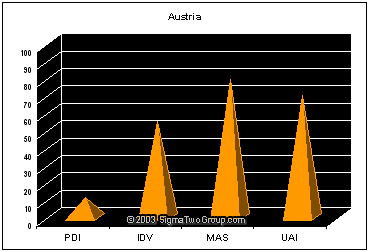Geert Hofstede’s research into national cultures from the 1960s onward has identified five primary dimensions of culture: Individualism, Masculinity, Uncertainty Avoidance, Long-Term Orientation, and Power Distance. This research has proven useful in a variety of contexts, from setting national policy to understanding corporate culture.
One of these five dimensions, the “Power Distance Index” (or PDI), measures the extent to which major differences between the most powerful and the least powerful (the “haves and have-nots”) are accepted within the culture.
The lowest Power Distance scores belong to countries that strongly emphasize equality, opportunities to rise in society, etc. The lowest-scoring countries on the index are Austria, Israel, Denmark, New Zealand, and Ireland.

In contrast, the highest Power Distance scores belong to countries where massive differences between the powerful and the powerless are normal and accepted parts of life. Countries with large Power Distance scores include Malaysia, Guatemala, Panama, the Philippines, and Mexico.

Hofstede’s cultural dimensions can be applied to companies as well, and each of them (including Power Distance) can have a significant effect on the way that company handles their marketing efforts.
Imagine what happens inside the marketing department of a high Power Distance company:
- Apart from numbers in spreadsheets, employees rarely notice any observable difference created by their actions.
- Employees are expected to stay in their place and not make waves.
- People who can actually make important decisions are inaccessible, protected by layers of middle management.
- Managers view employees who challenge norms or questioning decisions as disrespecting their authority.
- Priority is placed never making embarrassing mistakes, making it difficult to take a stand on anything.
- Managers are looking for immediately demonstrable results, leading to a focus on tactics over strategy.
- The powerful feel they have so much to lose that they instinctively go on the defense, only approving safe, comfortable, familiar solutions.
All these characteristics result in an environment where it’s almost impossible to develop effective marketing. Innovation is given lip service by executives, but seldom actually welcome in marketing efforts. Bold statements are watered down, color schemes dulled, and fresh conceptual ideas dismissed in favor of tried-and-true, easy-to-approve solutions.
By contrast, consider the environment provided by a low Power Distance organization:
- Employees see the results of their actions, and can really feel the difference between what works and what doesn’t.
- Creative ideas can come from anyone. Employees are encouraged to speak up instead of sitting quietly.
- Lower-level employees are empowered to make important decisions, allowing them to happen quickly and with more context.
- The company culture values employees who question decisions and challenge accepted norms.
- Employees are encouraged to try new ideas and allowed to fail gracefully, helping them feel it’s safe environment for innovation (which leads to the big game-changing ideas).
- Decision-makers understand that the day-to-day execution of a long-term vision isn’t always easily measurable. The culture encourages gut instincts, trust, and a willingness to let a strategy play out before killing it.
- Executives understand the dangers of comfort and monotony, and they demonstrate their willingness to attempt bold and innovative solution.
That’s a very different company, where employees are given the flexibility and encouragement they need to develop genuinely powerful marketing messaging that will grab the market and make potential customers sit up and pay attention.
It’s worth taking time to think seriously about what kind of company you’re working for, and how that culture affects the marketing efforts coming out of it. If you find yourself in a high Power Distance company, it may actually make sense to divert a significant percentage of the overall marketing budget into culture modification initiatives to help build some of that creative infrastructure and thinking within the company.




